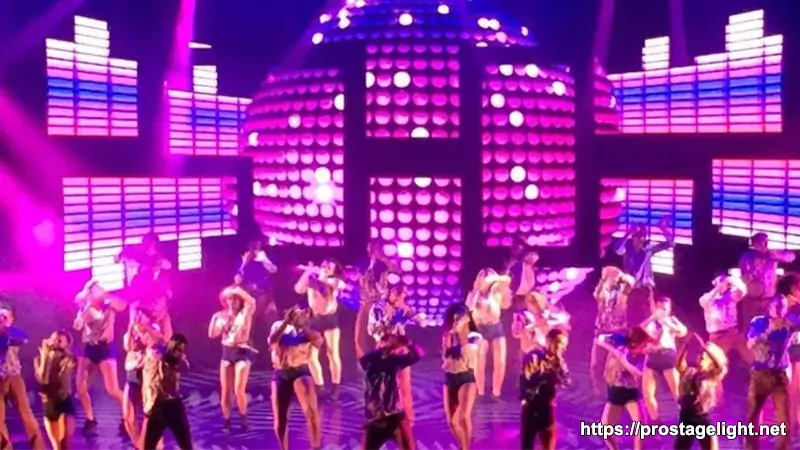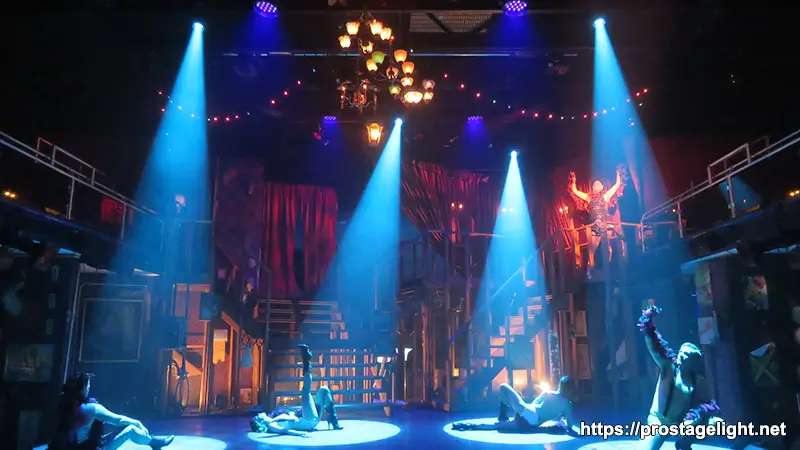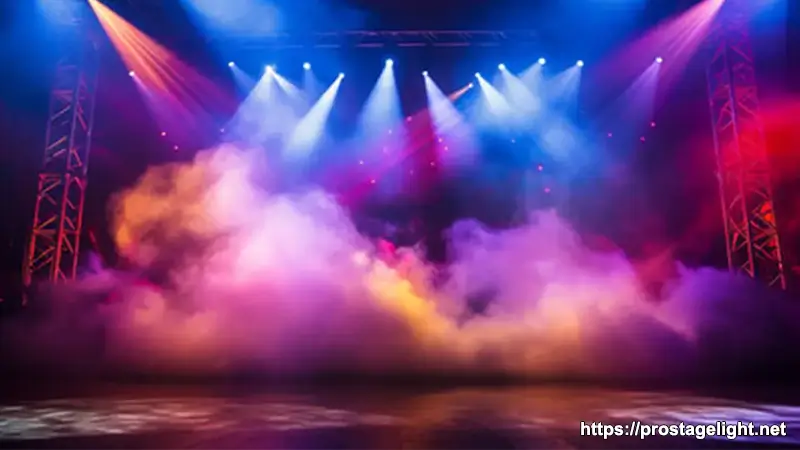Head beam lights are a powerful and versatile lighting fixture used in stage design to create dynamic and captivating performances. The right head beam lights can transform a performance and add a new dimension to the overall experience for the audience. In this blog post, we will explore the various types of head beam lights, how they work, their advantages, and how to choose the best ones for different types of performances. We will also discuss tips for using head beam lights, maintenance, and safety.

I. What are Head Beam Lights?
Definition of Head Beam Lights
- Head beam lights are a type of lighting fixture used in stage design to create dynamic and impactful performances. These lights typically have a narrow beam angle and can be used to highlight specific areas on stage, create dramatic lighting effects, and add depth to a performance.
History of Head Beam Lights
- The use of head beam lights in stage design can be traced back to the 1970s when automated lighting fixtures were first introduced. These early fixtures were large and bulky, but as technology advanced, they became more compact and versatile. Today, head beam lights are a staple in stage design and are used in a variety of performances ranging from concerts and music festivals to theater productions and corporate events.
Common Uses of Head Beam Lights
- Head beam lights are commonly used in stage design to create a wide range of lighting effects. They can be used to highlight specific areas on stage, create dramatic effects such as strobing and color changes, and add depth to a performance
II. How Head Beam Lights Work
Basic Principles of Head Beam Lights
- Head beam lights work by using a lamp or LED as the light source, which is then directed through a lens or reflector to create a focused beam of light. The angle of the beam can be adjusted to create different lighting effects.
Components of Head Beam Lights
- The main components of a head beam light include the lamp or LED, the reflector or lens, the color wheel, and the motorized moving head that allows the beam to be directed and adjusted.
Types of Head Beam Lights
- There are several types of head beam lights available in the market, including spotlights, wash lights, and moving head lights. Spotlights are typically used to highlight specific areas on stage, while wash lights are used to create a wide wash of color or light. Moving head lights, as the name suggests, can be directed and adjusted to create a range of lighting effects.
III. Advantages of Using Head Beam Lights
Increased Flexibility and Control
- One of the key advantages of using head beam lights is the increased flexibility and control they offer. With the ability to adjust the beam angle and direction, you can create a range of lighting effects and highlight specific areas on stage.
- Improved Color and Lighting Effects
- Enhanced Creativity in Stage Design
Lastly, head beam lights can enhance creativity in stage design by allowing for more creative and unique lighting effects. This can help to create a more immersive experience for the audience and add an extra dimension to the performance.
- IV. Using Head Beam Lights for Different Types of Performances
A. Concerts and Music Festivals - Concerts and music festivals are some of the most common types of performances that use head beam lights. The following are the types of head beam lights that are typically used in these types of performances:
Spotlights: Used to highlight specific areas on stage, such as the lead singer or guitarist.
Moving head lights: Used to create a range of lighting effects, including sweeping beams and dramatic color changes.
B. Theatre and Opera Performances - The following types of head beam lights are typically used in theatre and opera performances:
Fresnel lights: Used for general wash lighting and to create soft, even light.
Profile spotlights: Used to highlight specific areas on stage and create dramatic lighting effects.
Followspots: Used to follow performers as they move around the stage. - C. Corporate Events and Conferences
Head beam lights can also be used in corporate events and conferences to create a professional and polished look. The following are the types of head beam lights that are typically used in these types of events: - Wash lights: Used to create a wide wash of color or light.
Moving head lights: Used to create a range of lighting effects and highlight specific areas on stage.

V. Tips for Using Head Beam Lights
- Head beam lights are a powerful tool in the world of stage design, but in order to use them effectively, it is important to understand the best practices for their use. Here are some tips to help you get the most out of your head beam lights:
A. Proper Placement and Angle
Proper placement and angle are critical to achieving the desired lighting effects with head beam lights. Factors to consider when positioning your lights include the size and shape of the stage, the distance between the lights and the performers, and the desired lighting effects.
When it comes to angle, the general rule of thumb is to aim the lights at a 45-degree angle. This helps to create a more dynamic and dramatic effect. However, it's important to adjust the angle based on the specific needs of your performance.
B. Choosing the Right Light Intensity
The intensity of your head beam lights can have a big impact on the overall effect of your lighting design. It's important to choose the right intensity based on the size of your stage, the distance between the lights and performers, and the desired effect.
Understanding the different light intensity options available and their effects can help you make an informed decision when choosing your head beam lights.
C. Incorporating Moving Head Lights
Moving head lights can add an extra dimension to your lighting design by allowing you to create dynamic and fluid movements. They can be used to create a wide range of effects, from slow and subtle movements to fast and dramatic ones.
When incorporating moving head lights, it's important to consider factors such as the size and shape of the stage, the distance between the lights and performers, and the desired effect.
VI. Choosing the Best Head Beam Lights for Your Needs
- Choosing the right head beam lights is critical to achieving the desired lighting effects for your performance. Here are some factors to consider when making your selection:
- A. Factors to Consider When Choosing Head Beam Lights
Performance Needs and Requirements - Consider the specific needs and requirements of your performance, including the size and shape of the stage, the distance between the lights and performers, and the desired lighting effects.
- Budget and Price Range
- Head beam lights can range in price from a few hundred dollars to thousands of dollars. Determine your budget and price range before making a selection.
- B. Popular Brands and Models of Head Beam Lights
- There are many brands and models of head beam lights available on the market. Here are some of the most popular options:
- Review of Popular Brands and Models
- Compare the features and specifications of different brands and models to determine which one is the best fit for your performance.
Comparison of Different Brands and Models
Consider the pros and cons of each brand and model before making a selection.
C. Budget Considerations for Head Beam Lights
When it comes to budget considerations for head beam lights, there are a few things to keep in mind:
How Much Should You Spend on Head Beam Lights?
Determine your budget and price range before making a selection.
Factors That Affect the Cost of Head Beam Lights
Factors that can affect the cost of head beam lights include the size and shape of the lights, the features and specifications, and the brand and model.
VII. Maintenance and Safety of Head Beam Lights
- Proper maintenance and safety precautions are critical to ensuring the longevity and safe operation of your head beam lights. Here are some tips to help you maintain and operate your lights safely:
- A. Proper Maintenance of Head Beam Lights
- Routine Maintenance Tasks
- Regularly clean and inspect your head beam lights to ensure they are in good working condition.
- Cleaning Head Beam Lights
- Clean your head beam lights regularly to remove any dirt or debris that may affect their performance.
- B. Safety Precautions When Using Head Beam Lights
- Importance of Safety Precautions
- Always follow proper safety procedures
VIII. Head Beam Lights vs Other Lighting Options
- A. Comparing Head Beam Lights to Other Stage Lighting Options
When it comes to stage lighting, there are several options available for designers to choose from. Some of the common lighting options include spotlights, floodlights, wash lights, and PAR cans. However, head beam lights stand out as a popular choice due to their versatility, control, and dynamic effects.
B. Advantages of Head Beam Lights over Other Lighting Options
Compared to other stage lighting options, head beam lights offer several advantages. One of the main advantages is the ability to achieve precise and controlled lighting effects. With head beam lights, designers have the freedom to adjust the focus, direction, and intensity of the beam, allowing them to create unique and dynamic lighting designs.
Another advantage of head beam lights is their versatility. Unlike other lighting options that are limited in their range of movement, head beam lights can be rotated and tilted in various directions, making them suitable for a wide range of stage performances.
In addition, head beam lights are known for their brightness and ability to produce vibrant and vivid colors. With the use of color filters and gobos, designers can achieve a wide range of color effects, making head beam lights ideal for creating different moods and atmospheres on stage. - C. Limitations of Head Beam Lights Compared to Other Lighting Options
While head beam lights offer many advantages over other lighting options, they also have some limitations. One of the limitations of head beam lights is their narrow beam angle, which can make it challenging to achieve even lighting coverage over a large area. Additionally, head beam lights are not suitable for all types of stage performances and may require additional lighting options to create a well-rounded lighting design.
IX. Conclusion
- In conclusion, head beam lights are an essential element of dynamic stage design. They offer a range of advantages over other lighting options, including versatility, control, and vibrant color effects. However, they also have limitations that should be taken into consideration when designing a stage lighting setup. By understanding the strengths and weaknesses of head beam lights and other lighting options, designers can create a well-rounded and effective lighting design for any type of stage performance.
In the world of stage lighting, beam moving head lights have become increasingly popular for their dynamic capabilities. These professional moving head lights offer a wide range of possibilities for creating visually stunning displays. LED moving head lights in particular have become a popular choice, offering energy efficiency and longevity.
When choosing the best moving head lights for your needs, it's important to consider factors such as performance needs and budget. Proper placement and angle of head beam lights are crucial for achieving optimal lighting effects, as well as choosing the right light intensity. Moving head lights are a great way to incorporate dynamic movement into your stage design, and can be used for a variety of performances such as concerts, theatre, and corporate events.
However, it's important to note that head beam lights have their limitations and should be compared to other stage lighting options before making a final decision. Overall, incorporating moving head lights into your professional show lighting setup can greatly enhance the creativity and impact of your performance.

FAQ:
How do I choose the right head beam lights for my performance needs?
Consider the size and layout of your performance space to determine how many lights you need and what type of beams will work best.
Look for lights with a range of color and movement options to enhance your creativity and dynamic design.
Consider your budget and prioritize features that are most important for your specific performance needs.
How do I properly maintain and care for my head beam lights?
Regularly clean the lenses and filters to ensure optimal performance and reduce the risk of overheating.
Check all electrical connections and cables to make sure they are secure and functioning properly.
Keep the lights in a cool and dry environment when not in use to prevent damage from moisture and temperature fluctuations.
What are the advantages of using head beam lights over other types of stage lighting?
Head beam lights offer greater flexibility and control over the lighting effects, with the ability to move the beams and adjust the color and intensity.
They can create more dynamic and visually impressive designs, with the ability to create complex patterns and movement.
Head beam lights are also more energy efficient and cost effective compared to traditional stage lighting options.
